Family Name: Cactaceae Jussieu
Synonym(s): Leuchtenbergiaceae Salm-Dyck ex Pfeiff., nom. inval.; Opuntiaceae Desv.
Common Name(s): cactus family
*Number of genera/species: 127/1,750
List of genera records in GRIN-Global
Fruit berry-like or pear-like, 1.5–130 mm, globoseglobose:
3D shape—more or less spherical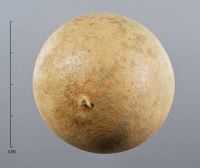 to clavateclavate:
to clavateclavate:
3D shape—club-shaped, with attachment at or near narrow end (compare obclavate)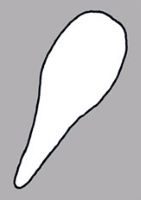 , tereteterete:
, tereteterete:
approximately circular in cross section; width and thickness approximately equal
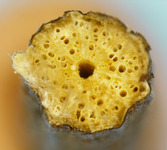 or compressedcompressed:
or compressedcompressed:
flattened; in grasses, used to denote compression (not necessarily flattened) either laterally or dorsiventrally
in transection, with few to many seeds, usually embedded in shoot-derived vegetative tissue (termed pericarpelpericarpel:
shoot-derived vegetative tissue that encloses the portion of the receptacle where the ovary and the stamens originate, differs from hypanthium in that lateral buds (areoles) are present, also known as "flower shoot", Cactaceae
or "flower shoot"), often with persistent perianthperianth:
collective term for calyx and corolla of a flower
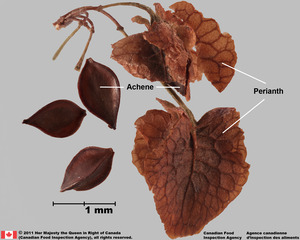 . AreolesAreole:
. AreolesAreole:
homologous to axillary or lateral bud located within a pit or groove in the stem, which may give rise to spines, glochids, vegetative branches, or floral branches, in Cactaceae
(axillary buds) are usually borne on pericarpelspericarpel:
shoot-derived vegetative tissue that encloses the portion of the receptacle where the ovary and the stamens originate, differs from hypanthium in that lateral buds (areoles) are present, also known as "flower shoot", Cactaceae
and usually produce hairs, spines, glochids, and/or scales. AreolesAreole:
homologous to axillary or lateral bud located within a pit or groove in the stem, which may give rise to spines, glochids, vegetative branches, or floral branches, in Cactaceae
may also produce flowers, branches, and roots, if flowers are produced then the fruits may appear as chains (Opuntia spp., Pereskia spp.).
Fruits indehiscentindehiscent:
not opening on its own, as in a fruit
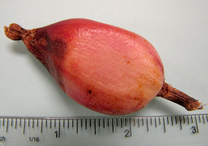 or dehiscentdehiscent:
or dehiscentdehiscent:
(v. dehisce) splitting open at maturity to release contents (of a fruit)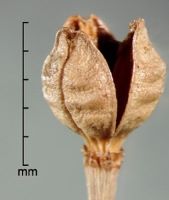 , if dehiscentdehiscent:
, if dehiscentdehiscent:
(v. dehisce) splitting open at maturity to release contents (of a fruit) then dehiscing longitudinally, sometimes appearing star-like, irregularly, or by apicalapical:
then dehiscing longitudinally, sometimes appearing star-like, irregularly, or by apicalapical:
at or pertaining to the end of the seed or fruit distal from its point of attachment (i.e., base)
slits or apicalapical:
at or pertaining to the end of the seed or fruit distal from its point of attachment (i.e., base)
or basalbasal:
at or pertaining to the point of attachment; (of embryo) embryo occupies one end of the seed
pores, or cracking, disintegrating, or deliquescing at maturity, rarely bursting. Fruits brightly colored or translucenttranslucent:
transmitting light uniformly and diffusely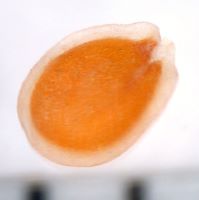 , shinyshiny:
, shinyshiny:
uniformly reflecting a high proportion of incident light at all angles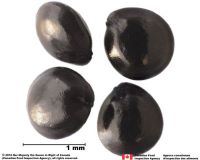 or dulldull:
or dulldull:
reflecting only a low proportion of incident light, with no apparent sheen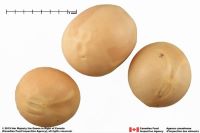 , rarely glaucous, usually thick walled, succulentsucculent:
, rarely glaucous, usually thick walled, succulentsucculent:
texture—herbaceous and juicy, often thickened
, leatheryleathery:
texture—moderately thick, tough, and very pliable
, sometimes dry at maturity and then hard, rarely paperypapery:
texture—papyraceous, chartaceous; very thin, pliable, and readily torn; like paper
, glabrousglabrous:
without hairs
or pubescentpubescent:
surface relief—bearing hairs
, sometimes densely so and appearing woolly, smooth or wartywarty:
surface relief—distinct, rounded projections that are large relative to the fruit size; tuberculate, verrucose or wrinkledwrinkled:
or wrinkledwrinkled:
surface relief—shallow, irregular folds and furrows covering the surface; appearing overall though crumpled and then spread out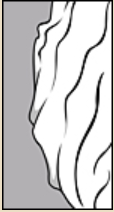 . Pulp is usually juicy or fleshy, sometimes a different color than pericarpelpericarpel:
. Pulp is usually juicy or fleshy, sometimes a different color than pericarpelpericarpel:
shoot-derived vegetative tissue that encloses the portion of the receptacle where the ovary and the stamens originate, differs from hypanthium in that lateral buds (areoles) are present, also known as "flower shoot", Cactaceae
. Fruits sometimes hollow at maturity with loose seeds.
Seeds usually globoseglobose:
3D shape—more or less spherical or pear-shaped, tereteterete:
or pear-shaped, tereteterete:
approximately circular in cross section; width and thickness approximately equal
 , compressedcompressed:
, compressedcompressed:
flattened; in grasses, used to denote compression (not necessarily flattened) either laterally or dorsiventrally
, or flattened, 0.4–12 mm. ArilsAril:
(broad sense) appendicular structure that wholly or partly envelops a seed and is produced from or a modification of the funicle, raphe, or outer integument; usually fleshy or pulpy, sometimes spongy or tufted-capillate, often brightly colored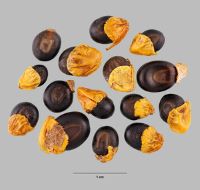 derived from the funicularfuniculus:
derived from the funicularfuniculus:
(alt. funicle) stalk connecting the ovule (later seed) to the ovary (later fruit) placenta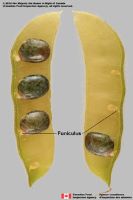 envelope present in Opuntioideae. If present, arilsaril:
envelope present in Opuntioideae. If present, arilsaril:
(broad sense) appendicular structure that wholly or partly envelops a seed and is produced from or a modification of the funicle, raphe, or outer integument; usually fleshy or pulpy, sometimes spongy or tufted-capillate, often brightly colored pale, often bonybony:
pale, often bonybony:
very hard and rather brittle, like bone
, glabrousglabrous:
without hairs
or rarely pubescentpubescent:
surface relief—bearing hairs
. Each aril tightly covers a seed. In Pterocactus, arilsaril:
(broad sense) appendicular structure that wholly or partly envelops a seed and is produced from or a modification of the funicle, raphe, or outer integument; usually fleshy or pulpy, sometimes spongy or tufted-capillate, often brightly colored form a broad, paperypapery:
form a broad, paperypapery:
texture—papyraceous, chartaceous; very thin, pliable, and readily torn; like paper
wing surrounding the seed body. Seed coat usually black or brown, shinyshiny:
uniformly reflecting a high proportion of incident light at all angles or dulldull:
or dulldull:
reflecting only a low proportion of incident light, with no apparent sheen , crustaceouscrustaceous:
, crustaceouscrustaceous:
texture—thin, dry, indurate, and brittle
or bonybony:
very hard and rather brittle, like bone
, glabrousglabrous:
without hairs
, sometimes hairy, smooth or striatestriate:
surface relief—having fine, parallel lines, grooves or ridges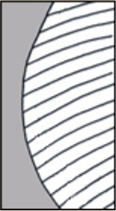 , wrinkledwrinkled:
, wrinkledwrinkled:
surface relief—shallow, irregular folds and furrows covering the surface; appearing overall though crumpled and then spread out , pittedpitted:
, pittedpitted:
surface relief—surface with small depressions in which the areas between the hollows do not take on the appearance of a true reticular net , wartywarty:
, wartywarty:
surface relief—distinct, rounded projections that are large relative to the fruit size; tuberculate, verrucose , sometimes reticulatereticulate:
, sometimes reticulatereticulate:
surface relief—netted, raised walls or concave grooves forming a net-like surface pattern with flat, concave, or convex interspaces or veinedveined:
or veinedveined:
surface relief—lines that intersect in a vein pattern that is flush or slightly raised from the surface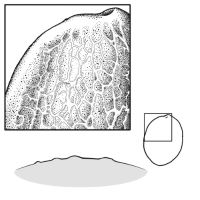 . HilaHilum:
. HilaHilum:
on seeds, the scar indicating where the funiculus was attached; on grass caryopses, the scar visible on the outer fruit surface revealing where the seed is attached on the inner fruit wall surface; or in Asteraceae cypselae, the scar visible on the outer fruit wall revealing where the fruit was attached to the receptacle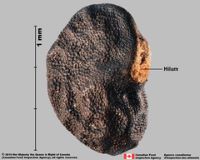 and micropylesmicropyle:
and micropylesmicropyle:
an opening in the integuments of an ovule usually acting as a passage for the pollen tube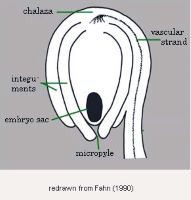 conjunct or fused. HilaHilum:
conjunct or fused. HilaHilum:
on seeds, the scar indicating where the funiculus was attached; on grass caryopses, the scar visible on the outer fruit surface revealing where the seed is attached on the inner fruit wall surface; or in Asteraceae cypselae, the scar visible on the outer fruit wall revealing where the fruit was attached to the receptacle small to large, circularcircular:
small to large, circularcircular:
(of embryo) linear embryo is curved into an "O" shape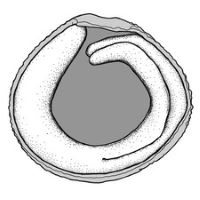 , basalbasal:
, basalbasal:
at or pertaining to the point of attachment; (of embryo) embryo occupies one end of the seed
or laterallateral:
(of embryo) embryo lies along the side of the seed, generally towards one end; of, at, or from the side; in grasses, can refer to the sides adjacent to the dorsal and ventral sides
. Larger hilahilum:
on seeds, the scar indicating where the funiculus was attached; on grass caryopses, the scar visible on the outer fruit surface revealing where the seed is attached on the inner fruit wall surface; or in Asteraceae cypselae, the scar visible on the outer fruit wall revealing where the fruit was attached to the receptacle sometimes deeply impressed.
sometimes deeply impressed.
Embryo well developed, completely to nearly filling seed cavity, peripheralperipheral:
(of embryo) embryo is curved around the outer edge of the seed, near the seed coat
, usually curvedcurved:
(of embryo) linear embryo is curved into an arch or horseshoe with the ends far apart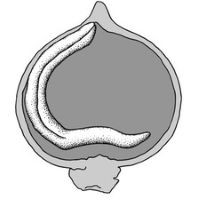 , arcuate to circinatecircinate:
, arcuate to circinatecircinate:
3D shape—terete and rolled downward from the apex in a tight coil
, cotyledons small.
Perispermperisperm:
seed nutritive tissue comparable to the endosperm, but derived from the nucellus (maternal tissue)
copious to scanty.
Opuntia monacantha has been considered a noxious weed or an invasive species in some areas in the world. It prefers moist, sunny situations and endures drought, barren conditions and can form predominant populations or monocultures in ruderal community or waste places. It spreads by seed reproduction.
Noxious Weeds: USA Federal Noxious Weed List, terrestrial, Opuntia aurantiaca Lindley.
Federal Noxious Weed Disseminules of the US tool provides a description and images of this species.
| Fruit | |
| Type | berry-like, pear-like |
| Size range | 1.5–130 mm long |
| Shape(s) | globoseglobose: 3D shape—more or less spherical  , urn-shaped, ellipsoidellipsoid: , urn-shaped, ellipsoidellipsoid:3D shape—elliptic , fusiformfusiform: spindle-shaped; broadest at the middle and tapering at both ends 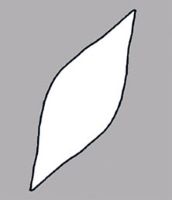 , ovoidovoid: , ovoidovoid:3D shape—ovate 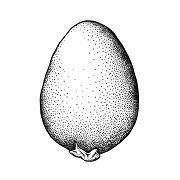 , conicalconical: , conicalconical:3D shape—cone-shaped, with the point of attachment at the broad end 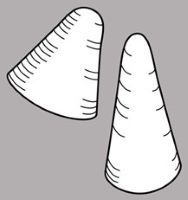 , oblongoblong: , oblongoblong:2D shape—much longer than broad with nearly parallel sides, corners are rounded 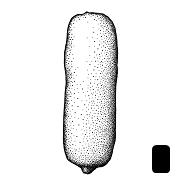 , barrel-shaped, pear-shaped, clavateclavate: , barrel-shaped, pear-shaped, clavateclavate:3D shape—club-shaped, with attachment at or near narrow end (compare obclavate)  |
| Texture | succulentsucculent: texture—herbaceous and juicy, often thickened , leatheryleathery: texture—moderately thick, tough, and very pliable , sometimes dry at maturity and then hard or rarely paperypapery: texture—papyraceous, chartaceous; very thin, pliable, and readily torn; like paper |
| Surface relief | smooth, wartywarty: surface relief—distinct, rounded projections that are large relative to the fruit size; tuberculate, verrucose  , wrinkledwrinkled: , wrinkledwrinkled:surface relief—shallow, irregular folds and furrows covering the surface; appearing overall though crumpled and then spread out  |
| Color(s) | black, purple, green, brown, yellow, orange, pink, red, white and translucenttranslucent: transmitting light uniformly and diffusely  , rarely blue, if green often tinged with brightly color, sometimes pulp a different color than peri carpelcarpel: , rarely blue, if green often tinged with brightly color, sometimes pulp a different color than peri carpelcarpel:a simple pistil that consists of a single ovary, style, and stigma |
| Unique features | Usually brightly colored, fleshy or juicy, berry-like fruits with areolesareole: homologous to axillary or lateral bud located within a pit or groove in the stem, which may give rise to spines, glochids, vegetative branches, or floral branches, in Cactaceae , often with tufts of spines and/or glochids or scales and with numerous seeds with curvedcurved: (of embryo) linear embryo is curved into an arch or horseshoe with the ends far apart  embryos. embryos. |
| Seed | |
| Size range | 0.4–12 mm long |
| Shape(s) | globoseglobose: 3D shape—more or less spherical  , comma-shaped, lenticularlenticular: , comma-shaped, lenticularlenticular:3D shape—lens-shaped; biconvex 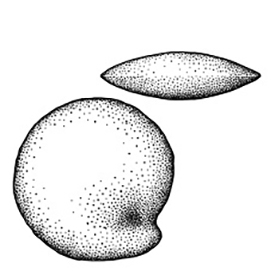 , cup-shaped, ellipsoidalellipsoid: , cup-shaped, ellipsoidalellipsoid:3D shape—elliptic , ovoidovoid: 3D shape—ovate  , pyriform, reniformreniform: , pyriform, reniformreniform:2D or 3D shape—kidney-shaped 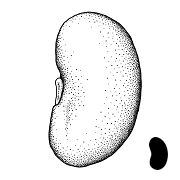 , angularangular: , angularangular:2D shape—having sides that meet at acute or obtuse angles , squarish, rarely snail-shaped; sometimes compressedcompressed: flattened; in grasses, used to denote compression (not necessarily flattened) either laterally or dorsiventrally or flattened |
| Surface relief | smooth, striatestriate: surface relief—having fine, parallel lines, grooves or ridges  , wrinkledwrinkled: , wrinkledwrinkled:surface relief—shallow, irregular folds and furrows covering the surface; appearing overall though crumpled and then spread out  , pittedpitted: , pittedpitted:surface relief—surface with small depressions in which the areas between the hollows do not take on the appearance of a true reticular net  , wartywarty: , wartywarty:surface relief—distinct, rounded projections that are large relative to the fruit size; tuberculate, verrucose  , sometimes reticulatereticulate: , sometimes reticulatereticulate:surface relief—netted, raised walls or concave grooves forming a net-like surface pattern with flat, concave, or convex interspaces  or veinedveined: or veinedveined:surface relief—lines that intersect in a vein pattern that is flush or slightly raised from the surface  |
| Color(s) | usually black or brown, sometimes gray, greenish yellow, yellow, red, or white |
| Unique features | Usually, dark-colored seeds with prominent hilahilum: on seeds, the scar indicating where the funiculus was attached; on grass caryopses, the scar visible on the outer fruit surface revealing where the seed is attached on the inner fruit wall surface; or in Asteraceae cypselae, the scar visible on the outer fruit wall revealing where the fruit was attached to the receptacle  and curvedcurved: and curvedcurved:(of embryo) linear embryo is curved into an arch or horseshoe with the ends far apart  embryos, sometimes arillate or strophiolate. embryos, sometimes arillate or strophiolate. |
| Other | |
| Embryo | well developed, completely to nearly filling seed cavity, peripheralperipheral: (of embryo) embryo is curved around the outer edge of the seed, near the seed coat , usually curvedcurved: (of embryo) linear embryo is curved into an arch or horseshoe with the ends far apart  , arcuate to circinatecircinate: , arcuate to circinatecircinate:3D shape—terete and rolled downward from the apex in a tight coil , cotyledons small |
| Nutritive tissue | perispermperisperm: seed nutritive tissue comparable to the endosperm, but derived from the nucellus (maternal tissue) copious to scanty |
Throughout the arid and semiarid regions of the Americas, with a single species native to the paleotropics, Rhipsalis baccifera
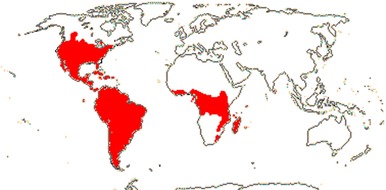
Distribution map courtesy of Angiosperm Phylogeny Website.
Anderson 2001Anderson 2001:
Anderson EF. 2001. The Cactus family. Timber Press, Portland Oregon. 776 pp.; Flora of North America Editorial Committee 1993+Flora of North America Editorial Committee 1993+:
Flora of North America Editorial Committee, eds. 1993+. Flora of North America North of Mexico [Online]. 22+ vols. Flora of North America Association, New York and Oxford. Accessed January-March 2024. URL: http://beta.floranorthamerica.org.; Kirkbride et al. 2006Kirkbride et al. 2006:
Kirkbride JH, Jr, Gunn CR, and Dallwitz MJ. 2006. Family guide for fruits and seeds, vers. 1.0. Accessed September 2020-January 2022. URL: https://nt.ars-grin.gov/seedsfruits/keys/frsdfam/index.cfm .; Kubitzki et al. 1990+Kubitzki et al. 1990+:
Kubitzki K et al., eds. 1990+. The families and genera of vascular plants. 7+ vols. Berlin etc.; Lentz and Dickau 2005Lentz and Dickau 2005:
Lentz DL and Dickau R. 2005. Seeds of Central America and Southern Mexico: The Economic Species. The New York Botanical Garden Press, New York. 298 pp.; Mauseth 2017Mauseth 2017:
Mauseth JD. 2017. An introduction to cactus areoles part I. Cactus and Succulent Journal 89: 128-134. https://doi.org/10.2985/015.089.0305; Rosas-Reinhold et al. 2021Rosas-Reinhold et al. 2021:
Rosas-Reinhold I, Piñeyro-Nelson A, Rosas U, and Arias S. 2021. Blurring the boundaries between a branch and a flower: Potential developmental venues in Cactaceae. Plants (Basel) 10(6):1134. https://doi.org/10.3390/plants10061134; Takhtajan 2009Takhtajan 2009:
Takhtajan A. 2009. Flowering plants: Second edition. Springer Nature, Switzerland. 871 pp.; Ulloa Ulloa et al. 2018 onwardsUlloa Ulloa et al. 2018 onwards:
Ulloa Ulloa C, Acevedo-Rodríguez P, Beck C, Belgrano MJ, Bernal R, Berry PE, Brako L, Celis M, Davidse G, Forzza RC, Gradstein SR, Hokche O, León B, León-Yánez S, Magill RE, Neill DA, Nee M, Raven PH, Stimmel H, Strong MT, Villaseñor JL, Zarucchi JL, Zuloaga FO, and Jørgensen PM. 2018 onwards. Vascular Plants of the Americas (VPA) Accessed January–May 2024. URL: http://www.tropicos.org/Project/VPA
*The number of genera and species is based on Christenhusz and Byng 2016Christenhusz and Byng 2016:
Christenhusz MJM and Byng JW. 2016. The number of known plant species in the world and its annual increase. Phytotaxa 261 (3): 201-217. https://doi.org/10.11646/phytotaxa.261.3.1, which may differ from the number of genera in GRIN-Global.